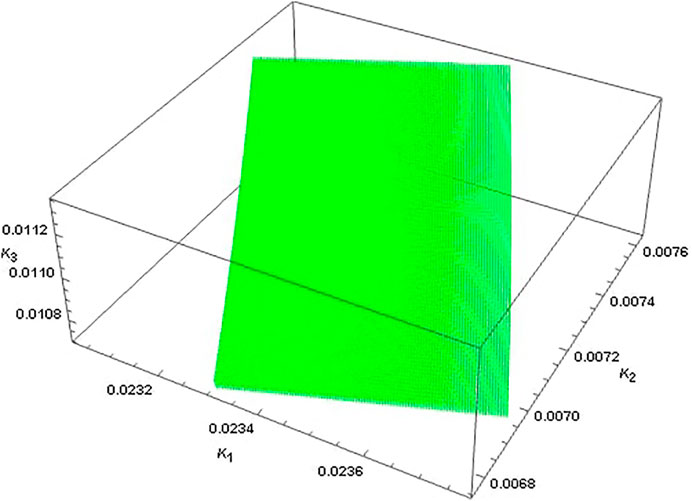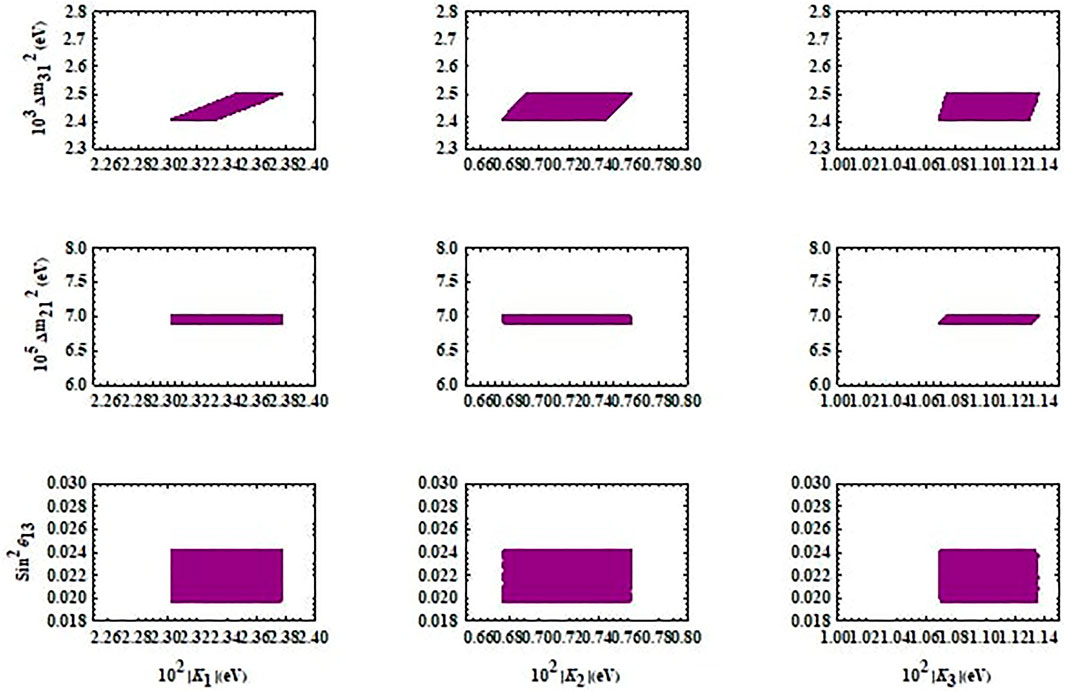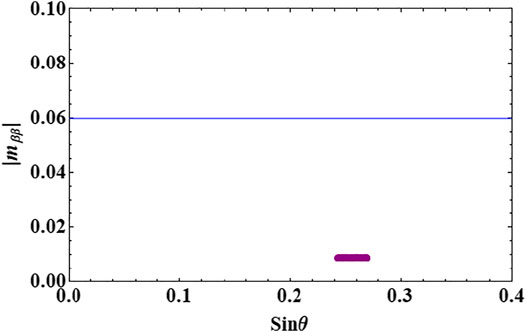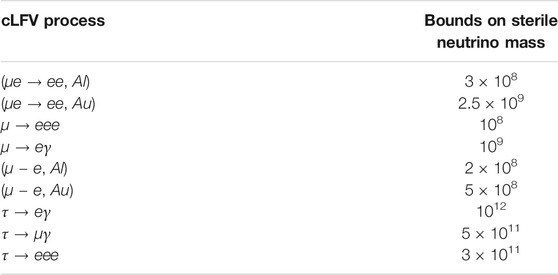- 1Department of Physics, Tezpur University, Tezpur, India
- 2Saha Institute of Nuclear Physics, Kolkata, India
We study the effect of sterile neutrino on some low-scale processes in the framework of the minimal extended seesaw (MES). MES is the extension of the seesaw mechanism with the addition of sterile neutrino of intermediate mass. The MES model in this work is based on Δ(96) × C2 × C3 flavor symmetry. The structures of mass matrices in the framework lead to TM1 mixing with μ–τ symmetry. The model predicts the maximal value of the Dirac CP phase. We carry out our analysis to study the new physics contributions from the sterile neutrino to different charged lepton flavor violation (cLFV) processes involving muon and tau leptons as well as neutrinoless double beta decay (0νββ). The model predicts normal ordering (NO) of neutrino masses, and we perform the numerical analysis considering normal ordering (NO) only. We find that a heavy sterile neutrino can lead to cLFV processes that are within the reach of current and planned experiments. The sterile neutrino present in our model is consistent with the current limits on the effective neutrino mass set by 0νββ experiments.
I Introduction
The observed neutrino oscillation phenomenon, the origin of the idea behind the massive nature of neutrinos, has been one of the most appealing evidence to expect physics beyond the standard model (BSM). Neutrino oscillation probabilities are dependent on the three mixing angles, the neutrino mass-squared differences (
Many searches for new physics beyond the standard model are going on in different experiments. Charged lepton flavor violation (cLFV) processes can provide a way to search for new physics beyond the standard model. cLFV processes are heavily suppressed in the standard model. However, the well-established neutrino oscillation phenomenon gives a signal toward the flavor violation in the charged lepton sector also. There are present and planned experiments to search for lepton flavor violating radiative decay (li → ljγ) [4] and also three body decays (li → ljlklk) [5]. The present and future experimental constraints on cLFV processes can be found in Tables 1, 2. In this work, we study the transition among the three charged leptons. However, the transitions of muon such as μ − e, N, μ → eee, μ → eγ [6, 7] and recently proposed μ−e− → e−e− [8] are extensively analyzed as the parent particle is substantially available in the cosmic radiation as well as in dedicated accelerators [9]. Many other challenging cLFV processes are those which involve the third family of leptons (taus) as it opens many flavor violating channels. Among these, τ → eγ, τ → μγ, τ → 3e, and τ → 3μ are significant. The processes involving taus also open up many channels involving hadrons in the final state such as τ → lπ0, τ → lπ+π− [9, 10].

TABLE 2. Experimental bounds for the process CR (μ − e, N) [13].
There are various theoretical models which are the extension of the SM that can account for cLFV processes [14–17]. These models usually introduce new particle fields to act as a source of flavor violation. The models with heavy sterile neutrinos can provide prominent contributions to cLFV processes. There are many theoretical motivations as well as experimental background for the existence of sterile neutrinos. The anomalies of the LSND [18] and MiniBooNE [19] results provide a hint toward the presence of one or two sterile neutrino states. Again from the theoretical point of view, the addition of sterile fermions into the standard model can explain the neutrino mass and also mixing [20, 21]. Moreover, sterile neutrinos can account for many cosmological observations such as dark matter [22–26] and baryon asymmetry of the universe (BAU) [27, 28]. Furthermore, their mixing with the active neutrinos can contribute to certain non-oscillation processes such as neutrinoless double decay (0νββ) amplitude or to beta decay spectra in the KATRIN experiment [29, 30]. To study the effect of sterile neutrino on low-scale processes, we have chosen the minimal extended seesaw (MES) framework augmented with Δ(96) flavor symmetry. In the MES framework, three right-handed neutrinos and one additional gauge singlet field S are added to the SM particle content [31, 32]. The extra sterile state may have a significant contribution to cLFV processes and 0νββ depending on its mass and mixing with the active neutrinos in the model. In the present work, C2 and C3 discrete groups are introduced along with Δ(96) to avoid the unwanted couplings among the particles. The mass matrices constructed in the MES model embedded with Δ(96) flavor symmetry lead to a particular mixing pattern widely known as TM1 mixing [33]. TM1 mixing is one of the most significant mixing patterns which comply with the experimental predictions on mixing angles and Dirac CP phase. In the present work, after constructing the mass matrices leading to TM1 mixing, the model parameters have been evaluated using three neutrino oscillation parameters, and then mass and mixing of the particles are calculated as a function of these model parameters. Furthermore, we have evaluated different observables characterizing the different cLFV processes and neutrinoless double beta decay (0νββ).
This paper is organized as follows. In Section II, we describe TM1 mixing and the model with Δ(96) flavor symmetry. The particles are assigned with different charges under the symmetry group, and the mass matrices involved in the model are constructed. Section III gives the brief discussion of different cLFV processes and contribution of sterile neutrinos to such processes. In Section IV, we briefly discuss the neutrinoless double beta decay process in the presence of heavy sterile neutrinos. The results of the numerical analysis are discussed in detail in Section V. Finally, we conclude in Section VI.
II Minimal Extended Seesaw With Δ(96) Flavor Symmetry and TM1 Mixing
A The Minimal Extended Seesaw Framework
The minimal extended seesaw (MES) is the extension of the canonical type I seesaw by the addition of extra gauge singlet field, νs, to accommodate sterile neutrinos. This field has a coupling with the heavy right-handed neutrino fields that are present in the type I seesaw [34, 35]. Thus, the Lagrangian in this MES model can be obtained as [36]
Subsequently, the mass matrix arising from the Lagrangian in Eq. 1 in the basis (νL, Nc, Sc) can be written as
Since the right-handed neutrinos are much heavier than the electroweak scale as in the case of the type I seesaw, they should be decoupled at low scales. Effectively, the full 7 × 7 matrix can be block diagonalized into a 4 × 4 neutrino mass matrix as follows [36]:
Assuming MS > MD, the active neutrino mass matrix of Eq. 3 takes the form
The sterile neutrino mass can be obtained as
The charged lepton mass matrix, in general, can be diagonalized using unitary matrices UL and UR as follows:
Again, we obtain the light neutrino masses using the unitary matrix Uν as
The 4 × 4 neutrino mixing matrix in the MES model using UL and Uν can be obtained as [36]
The matrix ULR that governs the active–sterile mixing in which R can be expressed as
is given as
Finally, the 3 × 3 lepton mixing matrix (PMNS matrix) can be written as [36]
Thus, the PMNS matrix can be obtained by multiplying the diagonalizing matrix of the charged lepton mixing matrix and that of the effective seesaw matrix. UL is an identity matrix in the framework where the charged lepton mass matrix is diagonal.
B TM1 Mixing
Trimaximal (TM1) mixing is a mixing ansatz that preserves the first column of tri–bimaximal mixing UTBM and mixes its second and third columns. It is a perturbation to TBM mixing, and we can write the mixing matrix as [37, 38]
Comparing the above mixing matrix in Eq. 14 with the standard PMNS mixing matrix, one can obtain the three mixing angles in terms of θ as follows [39]:
Jarlskog’s rephasing invariant JCP can be written in terms of the elements of the mixing matrix as
One can write the expression for the CP phase in the TM1 scenario as
For a given θ13(θ), TM1 mixing with μ–τ reflection symmetry leads to maximal CP violation. Again, it can be seen that if
C The Lagrangian
In this work, we have used Δ(96) flavor symmetry [40–43] giving rise to unique textures of the mass matrices involved in the MES model. For a brief discussion about properties of Δ(96) and its character table and tensor product rules, refer to Appendix A. Δ(96) symmetry is further augmented by C2 and C3 discrete flavor symmetries to get rid of some unwanted interactions. The particle assignments in the model are shown in Table 3.

TABLE 3. Fields and their respective transformations under the symmetry group of the model. Here, ω = ei2π/3 and
In our MES model, the lepton doublets of the SM and the SM gauge singlets transform as triplets 3i and
The Yukawa Lagrangian for the charged leptons and also for the neutrinos can be expressed as
We assume that the above Lagrangian is CP conserving. As a result, all parameters appearing in the Lagrangian become real. However, CP along with most of the discrete symmetries in the model is broken at a low-energy scale by the VEVs of the flavons.
In Eq. 21,
The neutrino Majorana mass term
The interactions between the sterile and the right-handed neutrinos are involved in
After spontaneous symmetry breaking (SSB), the scalar fields acquire VEVs which are assigned as
The above VEVs remain invariant under the following group actions:
Here, p, Q, and C are generators of Δ(96) provided in Appendix A. These group actions generate the residual symmetries of the corresponding VEVs. Also, they uniquely define the VEVs up to their norms. It can be shown that every potential constructed using an irreducible multiplet will have such unique alignments as stationary points (assuming a condition of non-vanishing norm) [44–46]. In Eqs. 27, 28, ω and
D The Mass Matrices Involved in the Model
The textures of the mass matrices involved in the MES model can be obtained using flavon alignments defined with residual symmetries under our flavor group. With these flavon alignments mentioned above, we obtain the charged lepton and the neutrino mass matrices. In the charged lepton sector,
The charged lepton mass matrix MC is diagonalized using the unitary matrix UL given as
UL is referred to as the 3 × 3 trimaximal matrix (TM) or the magic matrix:
and we obtain the masses of the charged leptons as
It is seen from Eq. 37 that the mass scale of the electron is suppressed by an additional factor
Again, from Eq. 22, we obtain the Dirac neutrino mass matrix as
Denoting
mD has the dimension of mass similar to the order of the SM fermion masses and r1 is dimensionless. The Majorana mass matrix for the heavy right-handed neutrinos can be obtained using the VEVs of ϕM and ϕMi in Eq. 23 as
Here also, we denote yMvM = mR and
mR has the dimension of mass at the scale of flavon VEV and r2 is dimensionless.
Finally, we obtain the mass matrix representing the coupling between right-handed neutrinos and sterile neutrinos as
or we can rewrite it as
where mS = ySvS has the dimension of mass.
The light neutrino mass matrix in the framework of the MES arising from the mass matrices in Eqs. 39, 41, 43 can be written using Eq. 3 as
where
The effective seesaw mass matrix in Eq. 44 can be diagonalized in two steps using the unitary matrices UBM and Uθ as
or one may write
In MES models, the mass of the lightest neutrino vanishes in the lowest order. The suppression of higher order terms will be at least of the order of
The matrix Uθ and the bimaximal matrix UBM in Eq. 48 are given by
where θ can be expressed in terms of the model parameters as
Comparing Eq. 48 with Eq. 7, we can write the neutrino diagonalizing matrix Uν as
Therefore, using Eq. 12, the PMNS matrix in this model can be expressed as
Here, ULUBM is the tri–bimaximal (TBM) mixing matrix with phases:
The multiplication of ULUBM with Uθ mixes its second and third columns resulting in the TM1 mixing matrix
Our construction of Mν given in Eq. 44 leading to TM1 mixing implies that m1 = 0, which rules out inverted hierarchy. Using this in Eq. 49 and comparing with Eq. 44, we can find the expressions for model parameters K1, K2, and K3 in terms of the parameters θ, m2, and m3 as
E- Sterile Neutrino Mass and Mixing in the Model
Apart from the active neutrinos, the mass and mixing of the sterile neutrino present in the model play a crucial role in cLFV processes which will be discussed in the next section. As mentioned above, the sterile neutrino mass can be obtained using Eq. 5, and we can write the mass term for sterile neutrinos as
The active–sterile mixing using Eqs. 9, 10 can be obtained as
In Eqs. 58–61, mD, mR, r1, and r2 are the model parameters.
III Charged Lepton Flavor Violation Processes
A Processes Involving Muonic Atoms
Many experiments such as MECO, SINDRUM II [46], and COMET [47] involved in searching for μ − e conversion with different targets. The observable characterizing this process is defined as
These experiments are running with different targets such as titanium (Ti), lead (Pb), gold (Au), and aluminum (Al) and give bounds for different targets. There are also some planned future experiments like the second phase of the COMET experiment, Mu2e [48], to improve the sensitivity of this cLFV process.
There are several theoretical models to account for such rare LFV processes. As explained in [49], in the extension of the standard model with one heavy sterile neutrino, such processes originate from one-loop diagrams involving active and sterile neutrinos with non-zero mixing angles. In the MES model, the conversion ratio can be written as [49]
Here, GF, sω, Γcap(Z) are the Fermi constant, sine of the weak mixing angle, and capture rate of the nucleus, respectively. Here,
Here, Qq represents the quark electric charge which is
However, for the heavier neutrinos which do not satisfy the small mass limit, we use the expressions of form factors given in [49]:
There may be flavor violating non-radiative decay of μ− into three electrons (μ → eee) [50]. The Mu3e experiment running at PSI is aimed at finding the signatures of this type of decay [51]. The branching ratio of this decay process can be written as
Here, the form factors can be obtained from Eqs. 65–68.
The MEG experiment [52] is aimed at investigating the LFV process μ → eγ, and there are many planned projects in the search for this kind of decay. In the framework of the minimal extended seesaw, the heavy neutrinos can cause μ → eγ decay. The branching ratio of the process can be given as
Here, the total decay width of the muon (Γμ) is obtained as
Another possible cLFV process is the decay of a bound μ− in a muonic atom into a pair of electrons (μ−e− → e−e−) proposed in [53]. This particular decay process offers several advantages over three body decay processes from the experimental point of view. There are different classes of extension of the SM which can show a contribution to such processes. In this model with one extra sterile state, the effective Lagrangian describing this process contains long-range interactions and local interaction terms. The branching ratio of such processes in muonic atoms, with an atomic number Z, can be expressed as
Here, τμ represents the lifetime of free muons and the lifetime
B Processes Involving Tau Leptons
There are many flavor violating channels open for tau lepton decays. The search for such decays involving taus is also challenging. Theoretical models which predict cLFV in the muon indicate a violation in the tau sector also. However, the amplitude of the process involving the tau channel is enhanced by many orders of magnitude in comparison with muon decays. Experiments such as BaBar [53] and Belle [54] provide limits to cLFV decays involving tau leptons. In this work, we have investigated three processes involving tau leptons τ → eγ, τ → μγ, and τ → eee. The branching ratios of these mentioned processes can be written as [54]
Here, Γτ represents the total width of tau leptons with an experimental value Γτ = 2.1581 × 10–12 GeV [55].
where the composite form factors
For the heavier neutrinos, we can use the expressions
The different loop functions involved in the above expressions can be seen in [55].
IV Neutrinoless Double Beta Decay (0νββ)
The presence of sterile neutrinos in addition to the standard model particles may lead to new contributions to lepton number violating interactions like neutrinoless double beta decay (0νββ) [55–57]. We have studied the contributions of the sterile state to the effective electron neutrino Majorana mass mββ [57, 58]. The most stringent bounds on the effective mass are provided by the KamLAND-ZEN experiment [59]:
The amplitude of these processes depends upon the neutrino mixing matrix elements and the neutrino masses. The decay width of the process is proportional to the effective electron neutrino Majorana mass mββ which in the case of standard contribution, i.e., in the absence of any sterile neutrino, is given as
The above equation is modified with the addition of sterile fermions and is given by [50, 60]
where m4 and Ue4 are the mass of the sterile neutrino and its couplings to the electron neutrino, respectively. | < k > |≃ 190 MeV represents the neutrino virtuality momentum.
V Results of Numerical Analysis and Discussions
It is evident from the above discussion that the neutrino mass matrix in Eq. 44 contains three model parameters K1, K2, K3. We can express the experimentally measured six oscillation parameters
The model leads to the TM1 parameter
Apart from studying active neutrino phenomenology, we have calculated different observables related to the different cLFV processes with the numerically evaluated model parameters. All the masses and mixing in the model are dependent on the model parameters which are highly constrained by the neutrino oscillation data. The masses and mixing of the active and sterile neutrinos in turn are related to the observables of different cLFV processes and also the 0νββ process as mentioned above. Hence, the same set of model parameters that are supposed to produce correct neutrino phenomenology can also be used to estimate the observables of different low-energy processes. Thus, this model is constrained by these processes also. The predictions of our model on the sum of the neutrino masses and the 0νββ can be found in Table 5. The motivation is to see if the neutrino mass matrix that can explain the neutrino phenomenology can also provide sufficient parameter space for other low-energy observables 0νββ, cLFV, etc. We also correlate the sterile neutrino mass with 0νββ and cLFV processes to see the impact of the sterile neutrino.

TABLE 5. Predictions of the model on different parameters. The value of mββ is taken from the KamLAND-ZEN experiment [62] and ∑mi from latest Planck data [63].
The effective mass (mββ) characterizing the 0νββ process along with the presence of heavy sterile neutrinos is calculated using Eq. 90. Figure 3 shows the effective mass against the sterile neutrino mass and mixing. For new physics contributions coming from extra sterile neutrinos, the effective mass is consistent with the upper bound (|mββ| ≤ 0.06 eV) followed by the data of the KamLAND-ZEN [59] experiment. It has been observed that the presence of very heavy sterile neutrinos in the model has no significant effect on the 0νββ process since mββ is proportional to

FIGURE 3. Prediction of the effective neutrino mass as a function of the sterile neutrino mass and mixing.
We have performed the analysis of μ − e conversion with two different targets—aluminum (Al) and gold (Au). Figure 5 shows the calculated conversion ratios with these two targets as a function of the mass of the sterile neutrinos. In both cases, the results are within the reach of current and future experiments. It has been observed that sterile neutrinos with mass 108 GeV can lead to such a process within the experimental bound.

FIGURE 5. CR (μ − e, N) as a function of the sterile neutrino mass with two different targets. The blue horizontal line represents the experimental bounds on this process.
We have seen the sterile neutrino contribution to the process μ−e− → e−e− in the model. Figure 6 shows the variation of branching ratios with the mass of the sterile neutrinos. It has been observed that, for targets with Al, the experimental limits are reached for a lower value of the mass of the sterile neutrinos (around 108 GeV) than in the case with Au (around 2.5 × 109 GeV). This shows that the cLFV process induced by an additional sterile neutrino could certainly be probed in near future experiments with aluminum targets. The stringent bound on the sterile neutrino mass to cause such a process is around 3 × 108 GeV.

FIGURE 6. BR (μ−e− → e−e−, N) as a function of the sterile neutrino mass with two different targets. The blue horizontal line represents the experimental bounds on this process.
Figure 7 indicates the impacts of sterile neutrino in the μ → eee process. It is evident from the figure that the branching ratios have a stronger experimental potential, with contributions well within the current (future) experimental reach for sterile masses above 2 × 109 (108) GeV.
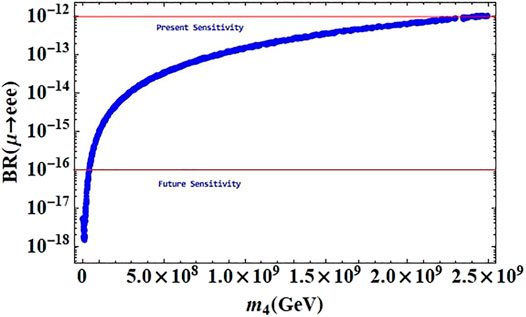
FIGURE 7. BR (μ − eee) as a function of the sterile neutrino mass. The red horizontal line represents the experimental bounds on this process.
The branching ratios of another appealing process μ → eγ in the presence of the heavy sterile neutrino as a function of its mass are shown in Figure 8. It is seen that the results are well within the current (future) experimental reach for sterile masses above 2 × 109 (109) GeV.
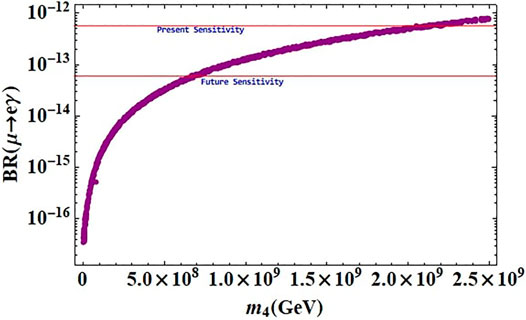
FIGURE 8. BR (μ − eγ) as a function of the sterile neutrino mass. The red horizontal line represents the experimental bounds on this process.
Similarly, we have carried out our analysis for processes involving tau atoms and calculated the observables using Eqs. 77–79. The results are shown in Figures 9–11. It is observed that the sterile neutrino can have sizable contributions to such processes only when it has mass above 109 GeV which is quite higher than that in the case of processes involving muonic atoms. For the process τ → eγ, the current experimental bound on the branching ratio is achieved for ms > 2 × 1012 GeV, and however, a lower mass of sterile neutrino (around 1012) can contribute to such processes in future experiments as shown in Figure 9. Figure 10 indicates that the contributions of sterile neutrino to the process τ → μγ are well within the current experimental limit for ms > 2 × 1012 GeV and the sensitivity of future experiments is reached for a lower mass of sterile neutrino (around 5 × 1011). For the process τ → eee, the current and future experimental bounds on the branching ratio are achieved for ms > 1012 GeV and around 3 × 1011, respectively, which can be seen in Figure 9. In Table 6, we have summarized the constraints on the sterile neutrino mass coming from different cLFV processes.
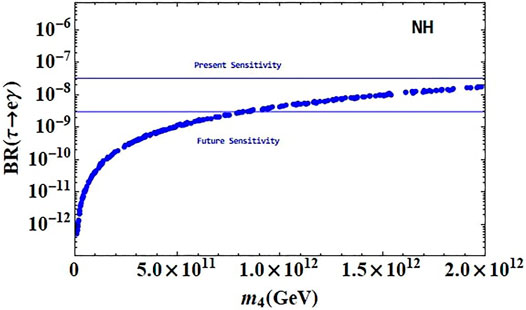
FIGURE 9. BR (τ − eγ) as a function of the sterile neutrino mass. The blue horizontal line represents the experimental bounds on this process.
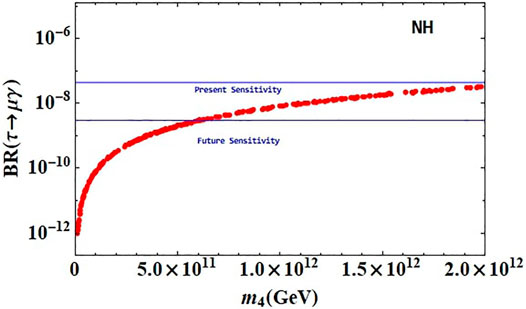
FIGURE 10. BR (τ − μγ) as a function of the sterile neutrino mass. The blue horizontal line represents the experimental bounds on this process.
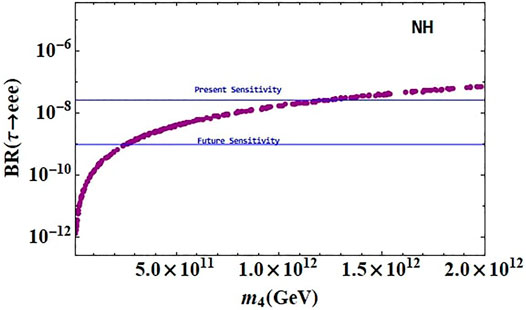
FIGURE 11. BR (τ − eee) as a function of the sterile neutrino mass. The blue horizontal line represents the experimental bounds on this process.
VI Conclusion
In this work, we have studied the effect of sterile neutrino on the low-energy processes focusing on charged lepton flavor violation and neutrinoless double beta decay. The framework of our study is an MES model which is obtained by the addition of a triplet of right-handed neutrinos and a sterile neutrino singlet field to the standard model. The gauge group of the standard model is extended by the flavor symmetry group Δ(96) along with two C2 groups and one C3 group. The model is constructed in such a way that it gives rise to a special mixing pattern known as TM1 mixing. Implementation of TM1 mixing in the MES framework with an extra sterile neutrino has been not done before. The model leads to TM1 mixing with μ–τ reflection symmetry which predicts the maximal atmospheric mixing angle and maximal breaking of the CP symmetry. These two important constraints of the model comply with the experimental data. Moreover, our construction of the model rules out the inverted ordering of the neutrino masses. The model is represented by three model parameters that have been evaluated by comparing the light neutrino oscillation parameters in the 3σ range. We have obtained the sterile neutrino mass and mixing from the model parameters. We then fed the model parameters in calculating different observables characterizing different low-energy processes. The textures of the mass matrices in our model predict the effective mass mββ that is consistent with the experimental data. We have investigated different cLFV processes involving muon and tau leptons. It has been observed that a wide range of parameter space can be probed in near future experiments. There are no theoretical upper bounds on the mass of the sterile neutrino. However, in this model, the different cLFV processes highly constrain the mass of the sterile neutrino. In this work, we have summarized the limits on the mass of the sterile neutrino to contribute such processes. Another important conclusion that can be drawn from the present work is that the sterile neutrino mass range allowed by different cLFV processes can give rise to an effective neutrino mass within the experimental limits. Thus, the two low-energy observables can also be correlated in the proposed model.
In conclusion, the MES model with Δ(96) discrete flavor symmetry can address neutrino phenomenology in the presence of heavy sterile neutrinos with the prediction of experimentally observed neutrino parameters. We have shown that the model has interesting implications in rare decay experiments such as lepton flavor violation and also neutrinoless double beta decay. The estimation of the model on baryon asymmetry of the universe (BAU) can also be studied in the future.
Data Availability Statement
The raw data supporting the conclusions of this article will be made available by the authors, without undue reservation.
Author Contributions
NG, RK, and MD conceptualized the idea. NG and RK performed the methodology, ran the software, involved in formal analysis, and visualized the results. NG wrote the original draft. RK and MD reviewed and edited the manuscript. MD involved in supervision, funding acquisition, and project administration.
Conflict of Interest
The authors declare that the research was conducted in the absence of any commercial or financial relationships that could be construed as a potential conflict of interest.
Publisher’s Note
All claims expressed in this article are solely those of the authors and do not necessarily represent those of their affiliated organizations, or those of the publisher, the editors and the reviewers. Any product that may be evaluated in this article, or claim that may be made by its manufacturer, is not guaranteed or endorsed by the publisher.
Acknowledgments
NG would like to acknowledge the Department of Science and Technology (DST), India (grant DST/INSPIRE Fellowship/2016/IF160994), for the financial assistantship. MKD acknowledges the Department of Science and Technology, Government of India, for the support under project no. EMR/2017/001436.
References
1. Acero MA, Adamson P, Aliaga L, Alion T, Allakhverdian V, Anfimov N, et al. New Constraints on Oscillation Parameters from νe Appearance and νμ Disappearance in the NOvA experiment. Phys Rev D (2018) 98:032012. doi:10.1103/PhysRevD.98.032012
2. Abe K. Measurements of Neutrino Oscillation in Appearance and Disappearance Channels by the T2K experiment with 6.6 × 1020 Protons on Target. Phys Rev D (2015) 91(7):072010. doi:10.1103/PhysRevD.91.072010
3. Mohapatra RN, Senjanović G. Neutrino Masses and Mixings in Gauge Models with Spontaneous Parity Violation. Phys Rev D (1981) 23:165–80. doi:10.1103/physrevd.23.165
4. Bernstein RH, Cooper PS. Charged Lepton Flavor Violation: An Experimenter’s Guide. Phys Rept (2013) 532(27–64). doi:10.1016/j.physrep.2013.07.002
5. Mihara S, Miller JP, Paradisi P, Piredda G. Charged Lepton Flavor-Violation Experiments. Annu Rev Nucl Part Sci (2013) 63:531–52. doi:10.1146/annurev-nucl-102912-144530
6. Lindner M, Platscher M, Queiroz FS. A Call for New Physics : The Muon Anomalous Magnetic Moment and Lepton Flavor Violation. Phys Rept (2018) 731:1–82. doi:10.1016/j.physrep.2017.12.001
7. Bertl W, au fnm, Engfer R, Hermes EA, Kurz G, Kozlowski T, et al. A Search for μ-e Conversion in Muonic Gold. Eur Phys J C (2006) 47:337–46. doi:10.1140/epjc/s2006-02582-x
8. Koike M, Kuno Y, Sato J, Yamanaka M. New Process for Charged Lepton Flavor Violation Searches:μ−e−→e−e−in a Muonic Atom. Phys Rev Lett (2010) 105:121601. doi:10.1103/physrevlett.105.121601
9. Calibbi L, Signorelli G. Charged Lepton Flavour Violation: An Experimental and Theoretical Introduction. Riv Nuovo Cim (2018) 41(2):71–174. doi:10.1393/ncr/i2018-10144-0
10. Hayasaka K, Inami K, Miyazaki Y. Search for Lepton Flavor Violating Tau Decays into Three Leptons with 719 Million Produced Tau+Tau- Pairs. Phys Lett B (2010) 687:139–43. doi:10.1016/j.physletb.2010.03.037
11. Baldini A. Search for the lepton flavour violating decay μ+ → e+γ with the full dataset of the MEG experiment. Eur Phys J C (2016) 76(8):434. doi:10.1140/epjc/s10052-016-4271-x
12. Aubert B, Karyotakis Y, Lees JP, Poireau V, Prencipe E, Prudent X, et al. Searches for Lepton Flavor Violation in the Decays τ± → e±γ and τ± → μ±γ. Phys Rev Lett (2010) 104:021802. doi:10.1103/PhysRevLett.104.021802
13. Bellgardt U, Otter G, REichler , Felawka L, Niebuhr C, Walter HK, et al. Search for the Decay mu+ — > e+ e+ e-. Nucl Phys B (1988) 299(1–6). doi:10.1016/0550-3213(88)90462-2
14. Deppisch F, Valle J. Enhanced Lepton Flavor Violation in the Supersymmetric Inverse Seesaw Model. Phys Rev D (2005) 72:036001. doi:10.1103/physrevd.72.036001
15. Ilakovac A, Pilaftsis A. Flavour-violating Charged Lepton Decays in Seesaw-type Models. Nucl Phys B (1995) 437:491–519. doi:10.1016/0550-3213(94)00567-x
16. Abada A, De Romeri V, Orloff J, Teixeira AM. In-flight cLFV conversion: $${e-\mu }$$ e - μ , $${e-\tau }$$ e - τ and $${\mu -\tau }$$ μ - τ in minimal extensions of the standard model with sterile fermions. Eur Phys J C (2017) 77(5):304. doi:10.1140/epjc/s10052-017-4864-z
17. Hernández-Tomé G, Illana J, Masip M, López Castro G, Roig P. Effects of Heavy Majorana Neutrinos on Lepton Flavor Violating Processes. Phys Rev D (2020) 101(7), 075020. doi:10.1103/PhysRevD.101.075020
18. Athanassopoulos C, Auerbach LB, Burman RL, Caldwell DO, Church ED, Cohen I, et al. Evidence for nu(mu) — > nu(e) neutrino oscillations from LSND. Phys Rev Lett (1998) 81:1774–7.
19. Aguilar-Arevalo AA, Brown BC, Bugel L, Cheng G, Conrad JM, Cooper RL, et al. Significant Excess of ElectronLike Events in the MiniBooNE Short-Baseline Neutrino Experiment. Phys Rev Lett (2018) 121(22):221801. doi:10.1103/physrevlett.121.221801
20. Naumov DV. The Sterile Neutrino: A Short Introduction. EPJ Web Conf (2019) 207:04004. doi:10.1051/epjconf/201920704004
21. Dev PSB, Pilaftsis A. Light and Superlight Sterile Neutrinos in the Minimal Radiative Inverse Seesaw Model. Phys Rev D (2013) 87(5), 053007. doi:10.1103/physrevd.87.053007
22. Gautam N, Das MK. Phenomenology of keV Scale Sterile Neutrino Dark Matter with S4 Flavor Symmetry. JHEP (2020) 2020. doi:10.1007/jhep01(2020)098
23. Adhikari R, Agostini M, Anh Ky N, Araki T, Archidiacono M, Bahr M, et al. A White Paper on keV Sterile Neutrino Dark Matter. JCAP (2017) 2017:025. doi:10.1088/1475-7516/2017/01/025
24. Dolgov A, Hansen S. Massive Sterile Neutrinos as Warm Dark Matter. Astropart Phys (2002) 16:339–44. doi:10.1016/s0927-6505(01)00115-3
25. Hamann J, Hannestad S, Raffelt GG, Wong YY. Sterile Neutrinos with eV Masses in Cosmology: How Disfavoured Exactly? JCAP (2011) 2011:034. doi:10.1088/1475-7516/2011/09/034
26. Dodelson S, Widrow LM. Sterile Neutrinos as Dark Matter. Phys Rev Lett (1994) 72(17–20):17–20. doi:10.1103/PhysRevLett.72.17
27. Lucente M. Implication of Sterile Fermions in Particle Physics and Cosmology. Ph.D. thesis. Orsay (2015).
28. Gautam N, Das MK. Neutrino Mass, Leptogenesis and Sterile Neutrino Dark Matter in Inverse Seesaw Framework. arXiv: 2001.00452 (2020).
29. Abada A, Hernández-Cabezudo A, Marcano X. Beta and Neutrinoless Double Beta Decays with KeV Sterile Fermions. JHEP (2019) 2019. doi:10.1007/jhep01(2019)041
30. Abazajian KN. Sterile Neutrinos in Cosmology. Phys Rept (2017) 711:1–28. doi:10.1016/j.physrep.2017.10.003
31. Zhang H. Light Sterile Neutrino in the Minimal Extended Seesaw. Phys Lett B (2012) 714:262. doi:10.1016/j.physletb.2012.06.074
32. Barry J, Rodejohann W, Zhang H. Light Sterile Neutrinos: Models and Phenomenology. JHEP (2011) 2011. doi:10.1007/jhep07(2011)091
33. Luhn C. Trimaximal TM1 Neutrino Mixing in with Spontaneous CP Violation. Nucl Phys B (2013) 875:80–100. doi:10.1016/j.nuclphysb.2013.07.003
34. Nath N, Ghosh M, Goswami S, Gupta S. Phenomenological Study of Extended Seesaw Model for Light Sterile Neutrino. JHEP (2017) 2017. doi:10.1007/jhep03(2017)075
35. Das P, Mukherjee A, Das MK. Active and Sterile Neutrino Phenomenology with A4 Based Minimal Extended Seesaw. Nucl Phys B (2019) 941:755–79. doi:10.1016/j.nuclphysb.2019.02.024
36. Krishnan R, Mukherjee A, Goswami S. Realization of the Minimal Extended Seesaw Mechanism and the TM2 Type Neutrino Mixing. JHEP (2020) 2020. doi:10.1007/jhep09(2020)050
37. King SF, Zhou Y-L. Trimaximal TM1 Mixing with Two Modular S4 Groups. Phys Rev D (2020) 101(1):015001. doi:10.1103/physrevd.101.015001
38. Chakraborty M, Krishnan R, Ghosal A. Predictive S4 Flavon Model with TM1 Mixing and Baryogenesis through Leptogenesis. JHEP (2020) 09.
40. Ding G-J. TFH Mixing Patterns, Large θ13 and Δ(96) Flavor Symmetry. Nucl Phys B (2012) 862:1–42. doi:10.1016/j.nuclphysb.2012.04.002
41. King SF, Luhn , C, Stuart AJ. A Grand Delta(96) X SU(5) Flavour Model. Nucl Phys B (2013) 867:203–35.
42. King SF, Neder T, Stuart AJ. Lepton Mixing Predictions from Δ(6n2) Family Symmetry. Phys Lett B (2013) 726:312–5. doi:10.1016/j.physletb.2013.08.052
43. Fonseca RM, Grimus W. Classification of Lepton Mixing Matrices from Finite Residual Symmetries. JHEP (2014) 2014. doi:10.1007/jhep09(2014)033
44. Michel L, Zhilinskii B. Symmetry, Invariants, Topology. Basic Tools. Phys Rep (2001) 341:7–9. doi:10.1016/s0370-1573(00)00087-9
45. Michel M. La genèse du recrutement de 1918 en Afrique noire française. Revue française d'histoire d'outre-mer (1971) 58:433–50. doi:10.3406/outre.1971.1561
46. Krishnan R. Symmetries of Stationary Points of the Potential and the Framework of the Auxiliary Group. Physical Review D (2021) 103. doi:10.1103/physrevd.103.l051701
47. Cui Y. Conceptual Design Report for Experimental Search for Lepton Flavor Violating Mu- - E- Conversion at Sensitivity of 10**(-16) with a Slow-Extracted Bunched Proton Beam (COMET) (2009):208.
48. Carey RM, Lynch KR, Miller JP, Roberts BL, Marciano WJ, Semertzidis YK, et al. Proposal to search for μ−N → e−N with a single event sensitivity below 10−16 (2008).
49. Abada A, De Romeri V, Teixeira A. Impact of Sterile Neutrinos on Nuclear-Assisted cLFV Processes. JHEP (2016) 2016. doi:10.1007/jhep02(2016)083
50. Kitano R, Koike M, Okada Y. Detailed Calculation of Lepton Flavor Violating Muon Electron Conversion Rate for Various Nuclei. Phys Rev D (2002) 66:096002. doi:10.1103/physrevd.66.096002
51. Willmann L, Schmidt PV, Wirtz HP, Abela R, Baranov V, Bagaturia J, et al. New Bounds from Searching for Muonium to Anti-muonium Conversion. Phys Rev Lett (1999) 82(49–52). doi:10.1103/physrevlett.82.49
52. Adam J, Bai X, Baldini AM, Baracchini E, Bemporad C, Boca G, et al. New constraint on the existence of the μ+ → e+γ decay. Phys Rev Lett (2013) 110:201801. doi:10.1103/PhysRevLett.110.201801
53. Miyazaki Y, Aihara H, Arinstein K, Aulchenko V, Bakich AM, Balagura V, et al. Search for Lepton-Flavor-Violating Tau Decays into a Lepton and a Vector Meson. Phys Lett B (2011) 699:251–7. doi:10.1016/j.physletb.2011.04.011
54. Benes P, Faessler A, Simkovic F, Kovalenko S. Sterile Neutrinos in Neutrinoless Double Beta Decay. Phys Rev D (2005) 71:077901.
55. Awasthi RL, Parida M, Patra S. Neutrinoless Double Beta Decay and Pseudo-dirac Neutrino Mass Predictions through Inverse Seesaw Mechanism (2013).
56. Borgohain H, Das MK. Phenomenology of Two Texture Zero Neutrino Mass in Left-Right Symmetric Model with Z8 × Z2. JHEP (2019). doi:10.1007/jhep02(2019)129
57. Blennow M, Fernandez-Martinez E, Lopez-Pavon J, Menendez J. Neutrinoless Double Beta Decay in Seesaw Models. JHEP (2010) 2010. doi:10.1007/jhep07(2010)096
58. Gando A, Gando Y, Hachiya T, Hayashi A, Hayashida S, Ikeda H, et al. Search for Majorana Neutrinos Near the Inverted Mass Hierarchy Region with KamLAND-Zen. Phys Rev Lett (2016) 117(8):082503-1–082503-6. doi:10.1103/PhysRevLett.117.082503
59. de Salas PF, Forero DV, Gariazzo S, Martínez-Miravé P, Mena O, Ternes CA, et al. 2020 Global Reassessment of the Neutrino Oscillation Picture. J High Energ Phys (2020) 2021. doi:10.1007/jhep02(2021)071
60. Capozzi F, Di Valentino E, Lisi E, Marrone A, Melchiorri A, Palazzo A, et al. Addendum to “Global Constraints on Absolute Neutrino Masses and Their Ordering”. Phys Rev D (2020) 101. doi:10.1103/physrevd.101.116013
61. Esteban I, Gonzalez-Garcia M, Maltoni M, Schwetz T, Zhou A. The Fate of Hints: Updated Global Analysis of Three-Flavor Neutrino Oscillations. J High Energ Phys (2020)(9) 2020. doi:10.1007/jhep09(2020)178
62. Aghanim N. Planck 2018 Results. VI. Cosmological Parameters. A&A (2018) 641:67. doi:10.1051/00046361/201833910
63. King SF, Neder T. Lepton Mixing Predictions Including Majorana Phases from Δ(6n2) Flavour Symmetry and Generalised CP. Phys Lett B (2014) 736:308–16. doi:10.1016/j.physletb.2014.07.043
Appendix AProperties of δ(96) Group
Δ(96) is one of the members of Δ6n2 with n = 4. The triplets
There are 11 irreducible representations of Δ(96), two singlets 1 and 1′, one doublet 2, six triplets 3,
Here, the tensor products of 1, 1′, 2, 3, 3′ follow the product rules of S 4:
For the Clebsch–Gordan coefficients all the above expansion, refer to [62, 63]. The tensor products involving 3
i
and
Keywords: numbers: 1260-i, 1460Pq, 1460St, neutrino, discrete flavor symmetry, lepton flavor violation (LFV), sterile neutrino
Citation: Gautam N, Krishnan R and Das MK (2021) Effect of Sterile Neutrino on Low-Energy Processes in Minimal Extended Seesaw With Δ(96) Symmetry and TM1 Mixing. Front. Phys. 9:703266. doi: 10.3389/fphy.2021.703266
Received: 30 April 2021; Accepted: 12 July 2021;
Published: 16 August 2021.
Edited by:
Narendra Sahu, Indian Institute of Technology Hyderabad, IndiaReviewed by:
Carlo Giunti, Universities and Research, ItalyBhupal Dev, Washington University in St. Louis, United States
Copyright © 2021 Gautam, Krishnan and Das. This is an open-access article distributed under the terms of the Creative Commons Attribution License (CC BY). The use, distribution or reproduction in other forums is permitted, provided the original author(s) and the copyright owner(s) are credited and that the original publication in this journal is cited, in accordance with accepted academic practice. No use, distribution or reproduction is permitted which does not comply with these terms.
*Correspondence: Mrinal Kumar Das, bWtkYXNAdGV6dS5lcm5ldC5pbg==
 Nayana Gautam
Nayana Gautam R. Krishnan
R. Krishnan Mrinal Kumar Das
Mrinal Kumar Das

